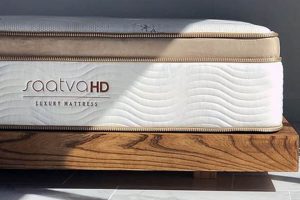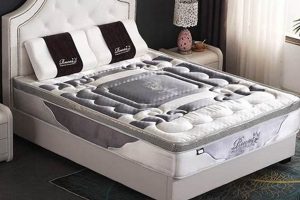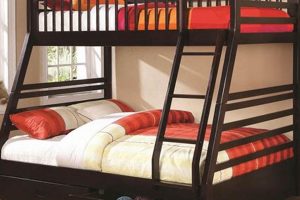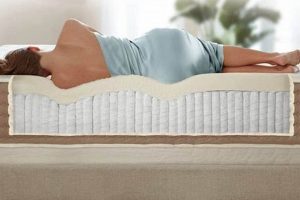A device utilized to sanitize and refresh bedding surfaces through the application of heated water vapor is designed to eliminate allergens, bacteria, and embedded dirt. Such a device offers a method of deep cleaning that surpasses traditional vacuuming, promoting a healthier sleeping environment.
The employment of such equipment contributes significantly to improved indoor air quality and the extension of a mattress’s lifespan. By mitigating dust mites and other potential irritants, it provides relief for allergy sufferers. The technology stems from industrial cleaning processes adapted for domestic use, offering a chemical-free alternative to harsh cleaning agents.
Subsequent sections will address critical factors to consider when selecting a mattress cleaning device, including steam temperature, features, and attachments, as well as best practices for ensuring optimal results and preventing damage to mattress materials.
Expert Advice for Optimal Mattress Sanitation
The following guidelines are essential for achieving a thorough and safe cleaning process, maximizing the effectiveness and longevity of the mattress cleaning equipment.
Tip 1: Prioritize Preparation: Before commencing, thoroughly vacuum the mattress surface to remove loose debris. This preliminary step ensures optimal steam penetration and prevents the redistribution of surface contaminants.
Tip 2: Implement Patch Testing: Apply steam to a discrete, inconspicuous area of the mattress to assess fabric compatibility and colorfastness. This precaution prevents potential damage or discoloration to the overall surface.
Tip 3: Maintain Controlled Moisture: Avoid oversaturation of the mattress material. Employ short, controlled bursts of steam, allowing adequate drying time between applications. Excessive moisture can promote mold growth or material degradation.
Tip 4: Employ Appropriate Attachments: Utilize specialized attachments designed for upholstery or mattress cleaning. These attachments optimize steam distribution and prevent direct nozzle contact, which can cause localized damage.
Tip 5: Ensure Adequate Ventilation: Conduct the cleaning process in a well-ventilated environment. This facilitates rapid drying and prevents the accumulation of humidity, minimizing the risk of mold or mildew formation.
Tip 6: Allow Thorough Drying: After completing the steaming process, allow the mattress to air dry completely, ideally for several hours. Utilize fans or open windows to expedite the drying process and ensure complete moisture evaporation.
Tip 7: Sanitize Regularly: Implement a regular cleaning schedule, ideally every six months, to maintain optimal hygiene and prevent the accumulation of allergens and dust mites. Consistent sanitation extends the lifespan of the mattress and promotes a healthier sleep environment.
Adhering to these guidelines will contribute to a cleaner, healthier sleep surface, extending the lifespan of the mattress and improving overall indoor air quality.
The subsequent section will explore frequently asked questions regarding mattress cleaning processes and equipment maintenance.
1. Steam Temperature
The efficacy of a mattress cleaning device is intrinsically linked to its steam temperature. Elevated temperatures, typically exceeding 212F (100C), are requisite for the effective eradication of dust mites, bacteria, and fungal spores embedded within mattress fibers. A lower temperature may prove insufficient to achieve adequate sanitization, thus compromising the primary objective of the cleaning process. For instance, steam generated below 180F (82C) might only superficially clean the mattress, failing to penetrate deep into the material and eliminate the underlying sources of allergens and pathogens. Therefore, the correlation between steam temperature and sanitization effectiveness is a crucial determinant of the device’s overall performance.
Mattress cleaning devices boasting adjustable temperature settings offer enhanced versatility, accommodating a wider range of mattress materials and cleaning requirements. Delicate fabrics, such as memory foam, may necessitate lower temperature settings to prevent damage or degradation. Conversely, thicker mattresses or heavily soiled areas may benefit from higher temperature steam for optimal results. The ability to regulate steam temperature allows users to tailor the cleaning process to the specific characteristics of their mattress, maximizing both cleaning efficacy and material preservation. Consider the example of a high-density foam mattress, which may require a higher temperature for effective sanitization compared to a thinner, less dense innerspring mattress.
In summary, steam temperature is a critical parameter influencing the performance of mattress cleaning equipment. The capacity to generate sufficiently high temperatures, coupled with the option for temperature adjustment, significantly enhances the device’s ability to sanitize mattresses effectively and safely. Understanding this relationship is essential for informed selection of mattress cleaning equipment and for achieving optimal cleaning outcomes. The absence of adequate steam temperature renders the device less effective and potentially detrimental to mattress hygiene.
2. Tank Capacity
Tank capacity is a critical determinant in assessing mattress cleaning equipment effectiveness. The volume of water a device can hold directly dictates the duration of continuous operation. A limited tank capacity necessitates frequent refills, interrupting the cleaning process and potentially affecting the consistency of steam application. For example, a device with a small tank, say 250ml, might only be sufficient for spot cleaning or treating a small section of a mattress, whereas a larger mattress requires a substantially larger volume to ensure thorough sanitation. Inadequate tank capacity can lead to incomplete cleaning and increased labor.
A larger tank capacity, typically exceeding 500ml, enables extended cleaning sessions without interruption. This is particularly advantageous when cleaning large mattresses or addressing heavily soiled areas. The continuous steam flow provided by a larger tank ensures consistent heat application, enhancing the effectiveness of pathogen and allergen removal. Consider the practical application of cleaning a king-size mattress; a device with a limited tank would require multiple refills, potentially allowing areas to cool before being fully sanitized, thus reducing overall effectiveness. Devices equipped with substantial reservoirs promote a more streamlined and thorough cleaning experience.
In summary, tank capacity is an integral component of mattress cleaning equipment. It directly affects the ability to clean effectively without interruption, impacting both cleaning efficacy and user convenience. Opting for
a device with an appropriate tank size, contingent on the size and cleaning needs of the mattress, is crucial. A device with a small tank size can reduce the benefit of the process, as the machine requires time to heat up again, thus reducing efficiency and overall sanitization. Selection based on this criterion is essential for achieving optimal cleaning results and maintaining a sanitary sleeping environment.
3. Attachment Variety
The assortment of attachments included with a mattress cleaning device directly influences its adaptability to diverse cleaning scenarios and mattress types. A comprehensive set of attachments enhances the equipment’s utility and contributes to a more thorough and tailored cleaning process.
- Upholstery Nozzle
An upholstery nozzle is designed for general surface cleaning, providing a wide steam distribution pattern suitable for larger, relatively clean areas. This attachment prevents concentrated steam application, which can damage delicate mattress fabrics. An example of its use includes refreshing the top surface of a lightly soiled memory foam mattress without risking over-saturation.
- Detailing Nozzle
A detailing nozzle, characterized by a smaller aperture, facilitates targeted steam application to localized stains or heavily soiled areas. This attachment allows for precise cleaning without affecting the surrounding fabric, effectively addressing issues such as accidental spills or pet stains. Its focused approach ensures optimal cleaning power in areas requiring specific attention.
- Fabric Brush
The inclusion of a fabric brush enhances the mechanical action of the cleaning process. The bristles aid in dislodging embedded dirt and debris, particularly within textured mattress surfaces. This attachment is beneficial for mattresses with intricate weaves or quilting patterns, ensuring thorough cleaning beyond the immediate surface. An example is agitating the fibers of a heavily used innerspring mattress to release trapped dust mites.
- Squeegee Attachment
A squeegee attachment is primarily used for moisture removal following steam application. By drawing excess water away from the mattress surface, this attachment accelerates the drying process and minimizes the risk of mold or mildew growth. This is particularly important for mattresses with moisture-sensitive components, such as latex or certain types of foam. A post-cleaning pass with a squeegee can significantly reduce drying time.
The availability of diverse attachments equips the user with the tools necessary to address a wide range of mattress cleaning challenges effectively. Without a comprehensive attachment set, the versatility and overall performance of a mattress cleaning device are inherently limited, potentially compromising the thoroughness and safety of the cleaning process. The presence of such attachments determines the degree to which the device can be considered a superior choice.
4. Weight and Maneuverability
The physical attributes of weight and maneuverability are integral determinants in evaluating mattress cleaning equipment. These factors directly influence user experience, cleaning efficiency, and the feasibility of regular maintenance. A cumbersome or unwieldy device can impede the cleaning process, discouraging consistent use and potentially leading to suboptimal hygiene.
- Device Weight and User Fatigue
The overall weight of the device significantly impacts user fatigue, particularly during extended cleaning sessions or when maneuvering the equipment across larger mattresses. A heavier device necessitates greater physical exertion, potentially limiting the user’s ability to maintain consistent steam application and thorough cleaning. The implications extend to individuals with mobility limitations or those seeking ease of use during routine mattress maintenance. The device’s mass must be considered alongside its features.
- Cord Length and Reach
Cord length directly correlates with the device’s operational range and maneuverability within a given space. A shorter cord restricts movement, requiring frequent repositioning of the power source and hindering the ability to reach all areas of the mattress without obstruction. Conversely, an extended cord offers greater freedom of movement, facilitating efficient cleaning across the entire mattress surface. Optimal cord length enhances user convenience and minimizes interruptions during the cleaning process. Cordless devices would negate this concern but introduce concerns of runtime and charging time.
- Handle Design and Ergonomics
The ergonomic design of the handle significantly contributes to user comfort and control during operation. A well-designed handle minimizes strain on the hand and wrist, allowing for prolonged use without discomfort. Handle design also influences the ease with which the device can be maneuvered around the mattress, particularly when navigating corners or tight spaces. An inadequately designed handle can lead to user fatigue and reduced cleaning effectiveness.
- Wheelbase and Stability
The design and stability of the wheelbase affect the device’s ease of movement and potential for tipping. A wide wheelbase provides enhanced stability, preventing accidental spills or interruptions during operation. Conversely, a narrow wheelbase may compromise stability, particularly on uneven surfaces or when navigating around furniture. The stability of the device directly impacts the user’s confidence and efficiency during the cleaning process.
The interplay between weight, maneuverability, and ergonomic design defines the overall user experience and the practical utility of mattress cleaning equipment. A device that balances these attributes provides a seamless and efficient cleaning process, encouraging regular maintenance and contributing to a healthier sleep environment. Failing to prioritize these ergonomic considerations can reduce the benefit of owning and operating such a machine.
5. Safety Features
Safety features in mattress cleaning devices are paramount, influencing user protection and preventing potential damage to mattress materials. These features are not merely supplementary; they are integral to the functionality of any equipment designated as the optimal choice for mattress sanitation. Neglecting safety considerations can result in user injury, property damage, or compromised mattress integrity.
- Automatic Shut-Off
An automatic shut-off mechanism deactivates the device upon detecting excessively high temperatures or low water levels, mitigating the risk of overheating and potential fire hazards. In instances of malfunction or user error, this feature prevents continued operation under unsafe conditions. For example, if a device were inadvertently left unattended with depleted water, the automatic shut-off would prevent the heating element from continuously operating, averting potential damage and hazards. The presence of this function underscores the inherent design for safety and is a
critical aspect. - Pressure Release Valve
A pressure release valve regulates internal pressure within the steam generating chamber, preventing over-pressurization and potential explosions. This safety measure is particularly important in devices that utilize high steam pressures for enhanced cleaning effectiveness. If pressure were to exceed safe limits, the valve would automatically release excess steam, ensuring the structural integrity of the device and the safety of the user. This is a particularly crucial safety feature to check.
- Insulated Nozzle and Housing
An insulated nozzle and housing minimize the risk of burns from contact with hot surfaces. These design elements prevent excessive heat transfer to the exterior of the device, ensuring that the user can handle the equipment without risk of injury. Direct contact with an uninsulated nozzle could result in severe burns, underscoring the importance of effective insulation for user safety. A cooler nozzle and housing improves safety of the machine.
- Child Safety Lock
A child safety lock prevents unintended activation of the device, particularly important in households with young children. This feature typically involves a locking mechanism that prevents the steam trigger from being engaged, thus minimizing the risk of accidental steam release and potential burns. Ensuring accessibility is limited to intended users is a critical safety consideration.
The incorporation of these safety features is indispensable for a mattress cleaning device to be considered the optimal selection. They safeguard the user from potential injury and protect the mattress from damage, contributing to a safer and more effective cleaning process. A device lacking these integral safety measures presents unacceptable risks and should be avoided.
6. Operating Time
Operating time, in the context of mattress cleaning equipment, defines the duration a device can function continuously without requiring refilling or recharging. Its relevance is pivotal when evaluating potential selections for the “best mattress steam cleaner,” as it directly impacts cleaning efficiency and overall user satisfaction.
- Tank Capacity and Continuous Operation
Tank capacity directly correlates with operating time. Larger tanks facilitate extended cleaning sessions without interruption. For instance, a device with a small tank might necessitate multiple refills when cleaning a king-size mattress, whereas a larger tank allows for uninterrupted cleaning. Inadequate operating time due to limited tank capacity compromises cleaning consistency and extends the overall process duration.
- Battery Life and Cordless Convenience
For cordless models, battery life determines the available operating time. Limited battery life necessitates frequent recharging, disrupting the cleaning workflow. Devices with extended battery life offer greater flexibility and convenience, enabling thorough cleaning of larger mattresses without interruption. Example: a cordless device with only 20 minutes of operating time may prove insufficient for cleaning an entire mattress effectively.
- Heat-Up Time and Initial Delay
The heat-up time required to reach optimal steam temperature can impact the perceived operating time. A device with a prolonged heat-up time reduces the effective cleaning time, as a portion of the operational window is consumed before steam is available. A shorter heat-up time allows for immediate use and maximizes the available cleaning period. Therefore, prompt steam delivery enhances the device’s practical operating time.
- Steam Output and Efficiency
Steam output rate influences operating time by depleting the water reservoir or battery at varying speeds. Devices with high steam output consume resources more quickly, potentially reducing the duration of continuous operation. Efficient steam delivery mechanisms, which optimize steam output without compromising cleaning effectiveness, contribute to extended operating time and reduced resource consumption. Balancing steam output and efficiency is key to maximizing the operational window.
In summary, operating time is a significant factor when assessing mattress cleaning equipment. Extended operating time facilitates uninterrupted and thorough cleaning, enhancing efficiency and user satisfaction. Devices with limited operating time necessitate frequent interruptions, compromising cleaning consistency and extending the overall process duration. Selection of a “best mattress steam cleaner” must consider the interplay between tank capacity, battery life, heat-up time, and steam output to ensure adequate and practical operating time for effective mattress sanitation.
Frequently Asked Questions Regarding Mattress Steam Cleaning
The following addresses common inquiries concerning mattress steam cleaning processes and equipment, intended to clarify misconceptions and provide evidence-based guidance.
Question 1: Does mattress steam cleaning effectively eliminate dust mites?
High-temperature steam, exceeding 212F (100C), demonstrably eradicates dust mites upon contact. The heat denatures proteins within the mites, causing immediate mortality. However, thorough cleaning requires consistent steam application to penetrate all mattress layers where dust mites may reside.
Question 2: Can steam cleaning damage my mattress?
Excessive moisture exposure can compromise certain mattress materials, particularly memory foam and natural latex. Employing controlled steam bursts and ensuring adequate drying time minimizes the risk of damage. Patch testing on an inconspicuous area is recommended prior to full-scale cleaning.
Question 3: How often should mattresses be steam cleaned?
A semi-annual cleaning schedule, performed every six months, is generally adequate for maintaining hygiene and mitigating allergen accumulation. Mattresses in households with allergy sufferers or pets may benefit from more frequent cleaning, conducted quarterly.
Question 4: What is the ideal drying time following steam cleaning?
Complete drying may require several hours, contingent on ambient humidity and mattress material. Employing fans or opening windows to enhance ventilation accelerates the drying process. The mattress should be entirely dry before covering with bedding to prevent mold growth.
Question 5: Is steam cleaning effective against bed bugs?
Steam cleaning can kill bed bugs upon direct contact. However, complete eradication requires meticulous treatment of all potential hiding places, including seams, crevices, and surrounding furniture. Professional pest control services are recommended for comprehensive bed bug infestations.
Question 6: Can mattress steam cleaning remove stains?
Steam cleaning can aid in lifting some stains, particularly those of recent origin. However, deeply embedded stains may require pretreatment with specialized cleaning solutions before steam application. The efficacy of stain removal varies based on the stain’s composition and age.
This FAQ section underscores the importance of informed decision-making when undertaking mattress steam cleaning, emphasizing the need for appropriate techniques and equipment to achieve optimal results.
The subsequent segment will address the long-term maintenance and care of mattress cleaning equipm
ent, ensuring prolonged operational lifespan and consistent performance.
Concluding Remarks on Mattress Cleaning Equipment
The preceding analysis has underscored the multifaceted considerations inherent in selecting a mattress cleaning apparatus. Key attributes such as steam temperature, tank capacity, attachment variety, maneuverability, safety mechanisms, and operating duration have been presented as critical determinants influencing cleaning efficacy and user experience. The effective application of such equipment contributes significantly to improved hygiene and the mitigation of allergens within the sleeping environment.
Therefore, prospective purchasers are urged to meticulously evaluate their specific needs and priorities before acquiring a device. A well-informed decision, grounded in a comprehensive understanding of the outlined factors, will yield a worthwhile investment that promotes both personal health and the longevity of bedding materials. Continued diligence in mattress maintenance remains paramount for sustained well-being.


![Top-Rated: Best All Foam Mattress for Pain Relief [2024] Organic & Natural Mattress Buyer’s Guide: Non-Toxic Sleep Solutions Top-Rated: Best All Foam Mattress for Pain Relief [2024] | Organic & Natural Mattress Buyer’s Guide: Non-Toxic Sleep Solutions](https://mattressworldpa.com/wp-content/uploads/2025/07/th-7641-300x200.jpg)




![Top-Rated: Best Twin Size Air Mattress [Guide] Organic & Natural Mattress Buyer’s Guide: Non-Toxic Sleep Solutions Top-Rated: Best Twin Size Air Mattress [Guide] | Organic & Natural Mattress Buyer’s Guide: Non-Toxic Sleep Solutions](https://mattressworldpa.com/wp-content/uploads/2025/07/th-7636-300x200.jpg)